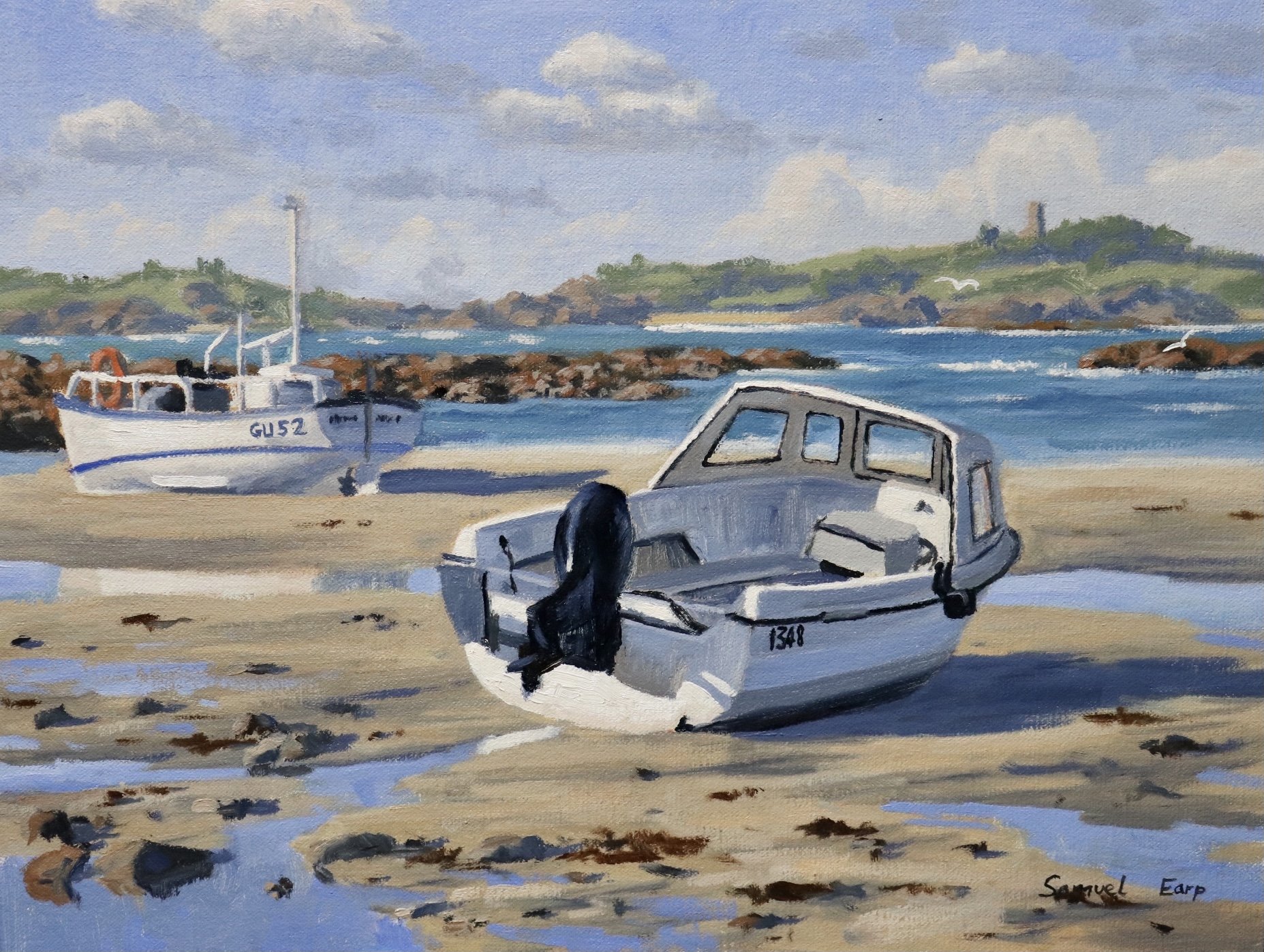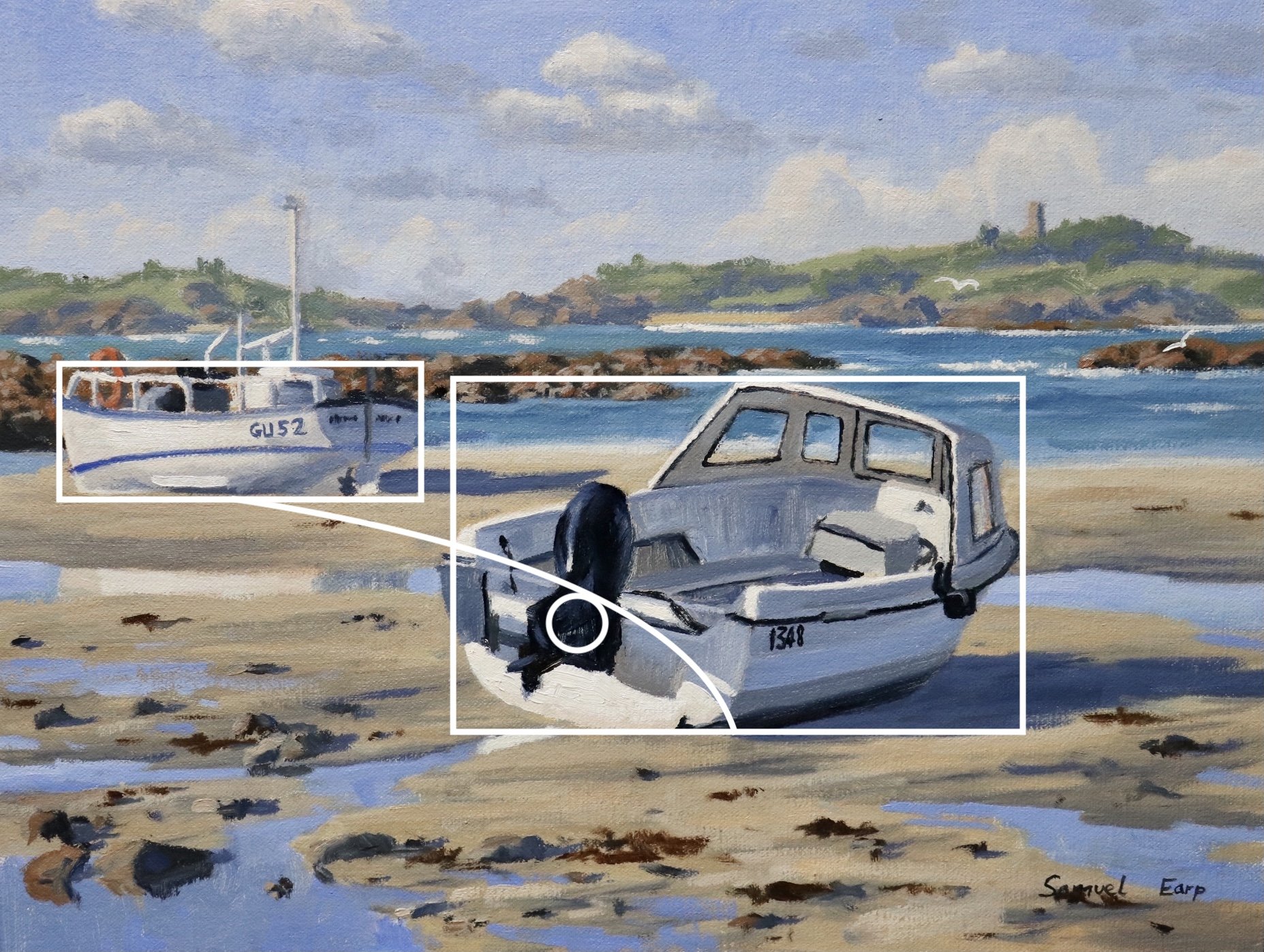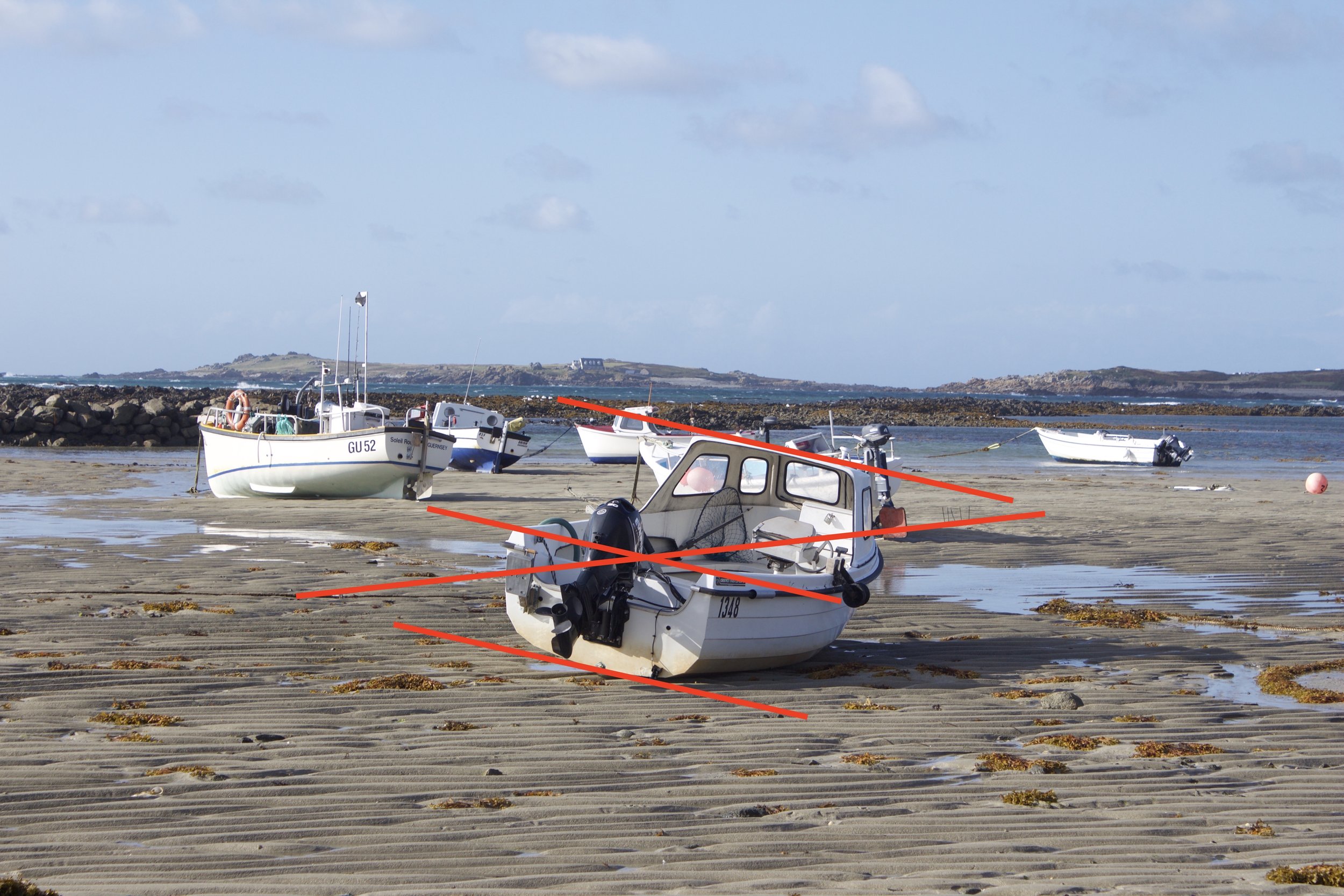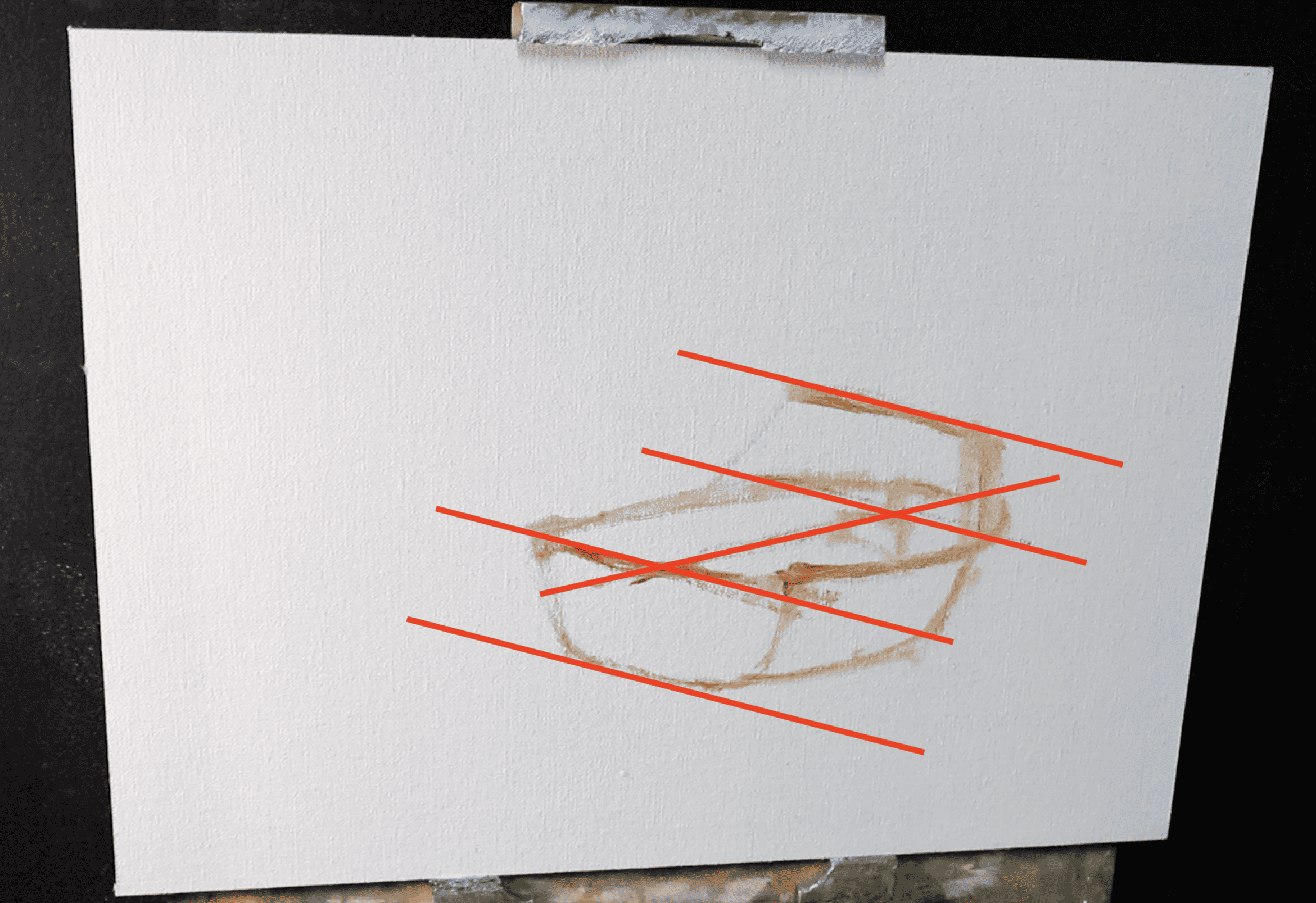
In this blog post I will demonstrate how to paint fishing boats in this scene inspired by a place called Rocquaine Bay in the island of Guernsey.
Suitable for oils and acrylics.
Reference Photo
Here is a reference photo I took and used in this painting. Please feel free to use or copy this photo if you would like to have a go at painting this art work.

Composition
The composition in this painting follows a ‘steelyard’ design and this is where you have a large mass that is counter balanced by a smaller mass on imaginary balanced scales. In this case the fishing boat in the foreground is counterbalanced by the boat in the mid ground on the left side of the painting. The steelyard composition communicates balance.

Colours
I painted this artwork using oil paint and the colours I used in this painting are as follows:
- Titanium white
- Burnt sienna
- Yellow ochre
- Cadmium yellow
- Cadmium orange
- Alizarin crimson
- Ultramarine blue
- Phthalo green
Brushes
Here is a list of the brushes I used in this painting:
- No.5 flat
- No.3 flat
- No.2 flat
- No.3 filbert
- No.0 round
Painting Demonstration
Stage 1 – Blocking in the Painting
I am painting on an 12” x 16” linen panel. The panel is pre made with a medium weave linen that is oil primed.
I sketch the composition using a No.1 round brush with burnt sienna mixed with Liquin Original (Liquin). I am using Liquin as a medium to thin the paint and it also has the advantage of speeding up the drying time.
Tips For Sketching the Boats
Boats can be complex structures so sketching them on your canvas in order to paint them can be tricky especially if the boat is leaning at an angle like it is in the image below. To make the sketching process easier I identified the major planes in the boats as shown in the image below.

As I was sketching out the boats in my painting I marked in the lines which allowed me to get the proportions of the boat correct as well as the angle it was leaning at. Once I was happy with the way I had marked out the shape of the boat I then wiped off the lines with a rag and continued to sketch out the rest of the composition.

Here is the composition all sketched out with burnt sienna ready for me to start painting it.

Paint Your Dark Values and Shadows First
I paint my dark values and shadows first whenever I start a painting. Value refers to how light or dark a subject and I find it easiest to create atmospheric depth in a painting by establishing the main areas of shadows first. By doing this it makes it much easier to paint in the areas in light and to get the saturation of your colours looking good.
The main areas of shadow in this painting are in the boats, distant headlands and clouds. The boats are mostly white and so the shadows are not as dark. Most of the shadow colours I have mixed are neutral greys that have a blue cast to them. I used varying combinations of ultramarine blue, burnt sienna, titanium white and a little alizarin crimson.
By using these same colours for most of the shadows in this painting I am creating colour harmony as I am using common colours throughout.

Once the main shadow areas have been established I now have points of reference to work from tonally meaning it is going to be easier to create atmospheric perspective in the painting.
I start painting the furthest zone away in the scene, in this case the sky and I worked forward.
The sky is a mix of titanium white and ultramarine blue and the cloud highlights are a mix of titanium white and burnt sienna.
For the distant headlands it is important that I use low chroma colours so the greens site back in the landscape. If the colours are too saturated they will leap forward in the painting and the atmospheric perspective would be lost.
The green in the hills is a mix of ultramarine blue, yellow ochre and titanium white.

I paint the sea and sand on the beach. The sea is a mix of ultramarine blue, yellow ochre, titanium white and a little phthalo green all of which have been mixed in varying amounts to create different hues and tones.
The sand is a pale low chroma yellow which I mixed using yellow ochre, alizarin crimson, titanium white and ultramarine blue.
The puddles of water are reflecting the sky and this is a mix of ultramarine blue and titanium white.

I create texture within the sand by adding some darker shades using the same colours I used a moment ago but with more ultramarine blue and alizarin crimson added. The darker shadows in the sand are a mix of ultramarine blue, burnt sienna, alizarin crimson and titanium white.
The rocks in the mid ground are a mix of yellow ochre, burnt sienna, ultramarine blue and titanium white.

The blocking-in stage is coming together and here I paint the highlights on the boat using a combination of titanium white with a little burnt sienna and ultramarine blue so the value is a little darker. I do this so that when I paint the final highlights on the boat it will give it another dimension that will make it look realistic.
I paint around the cabin and then I add the black borders around it using a mix of ultramarine blue and burnt sienna. These are the same colours I used for the outboard motor as well.
Once the blocking-in stage was complete I allowed the painting to dry so I can begin building up the details within the scene.

Stage 2 – Adding Details
Once my painting was dry I spent time adding details to it. In general I used the same colours as I used during the blocking in stage but as I add more details I built up lighter layers. This helps to create more depth and realism in the painting.
During the session on this painting I mainly worked on the sand, adding some lighter layers of paint to it as well as some details such as rocks and stones.

Stage 3 – Final Details
It is at this stage that I have saved my lightest values until the end of this painting and this mainly involved painting highlights on the stern of the boat using a mix of titanium white with a little burnt sienna.
I added more layers to the shadow areas of the boats to build up texture again using the same colours I used during the blocking-in stage, a mix of ultramarine blue, burnt sienna, titanium white and a little alizarin crimson.
I add details such as the black borders around the windows of the boat and also the numbers painted on the starboard side of the hull.

Thanks for reading 😊